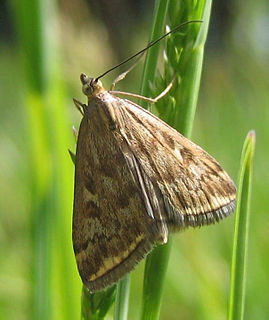
Willem-Alexander is King of the Netherlands, having acceded to the throne following his mother's abdication in 2013.

The following is a list of public holidays in Romania. According to Romanian law, Romania had 51 public holidays as of 2011, which cover 14% of the days of the year in the country.

Loxostege sticticalis is a species of moth of the family Crambidae. It was first described by Carl Linnaeus in 1761 and is found in the Palearctic and Nearctic realms.

Loxostege is a genus of moths of the family Crambidae.
Loxostege ephippialis is a species of moth in the family Crambidae. It was described by Johan Wilhelm Zetterstedt in 1839. It is found in Norway, Sweden, Finland, Russia and North America.

Loxostege turbidalis is a species of moth in the family Crambidae. It was described by Treitschke in 1829. It is found in most of Europe, except Ireland, Great Britain, Norway, the Benelux and the Iberian Peninsula. It has also been recorded from Russia, Turkey, China and Japan.

Loxostege argyrostacta is a moth in the family Crambidae. It was described by George Hampson in 1910. It is found in the Democratic Republic of the Congo and Zambia.
Loxostege brunneitincta is a moth in the family Crambidae. It was described by Eugene G. Munroe in 1976. It is found in North America, where it has been recorded from California, Oregon, Nevada and Colorado.
Loxostege decaryalis is a moth in the family Crambidae. It was described by Hubert Marion and Pierre Viette in 1956. It is found on Madagascar.
Loxostege egregialis is a moth in the family Crambidae. It was described by Eugene G. Munroe in 1976. It is found in North America, where it has been recorded from southern Arizona.

Loxostege flavinigralis is a moth in the family Crambidae. It was described by George Hampson in 1910. It is found in Zambia.
Loxostege floridalis, the Christmas-berry webworm moth, is a moth in the family Crambidae. It was described by William Barnes and James Halliday McDunnough in 1913. It is found in North America, where it has been recorded from Florida and Texas.
Loxostege impeditalis is a moth in the family Crambidae. It was described by Peter Maassen in 1890. It is found in Ecuador.

Loxostege lepidalis is a moth in the family Crambidae. It was described by George Duryea Hulst in 1886. It is found in North America, where it has been recorded from Alberta and eastern Washington to California and New Mexico.
Loxostege kearfottalis is a moth in the family Crambidae. It was described by E. V. Walter in 1928. It is found in North America, where it has been recorded from California to western Texas and in Colorado.
Loxostege oblinalis is a moth in the family Crambidae. It was described by Cajetan Felder, Rudolf Felder and Alois Friedrich Rogenhofer in 1875. It is found in the Democratic Republic of the Congo and South Africa.
Loxostege sierralis is a moth in the family Crambidae. It was described by Eugene G. Munroe in 1976. It is found in North America, where it has been recorded from British Columbia, Saskatchewan, Washington, Utah, Oregon and California.
Loxostege thrallophilalis is a moth in the family Crambidae. It was described by George Duryea Hulst in 1886. It is found in North America, where it has been recorded from southern British Columbia to northern California, as well as from Montana.
Loxostege triselena is a moth in the family Crambidae. It was described by Edward Meyrick in 1937. It is found in the Democratic Republic of the Congo.





